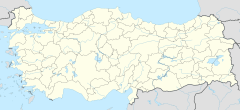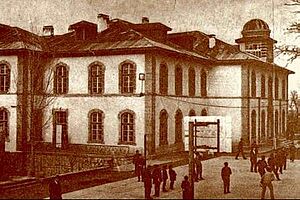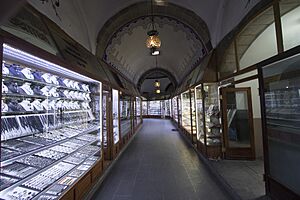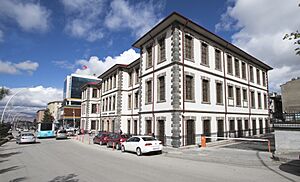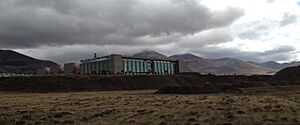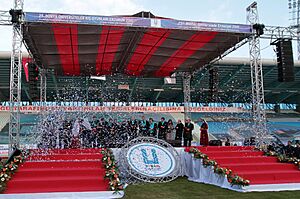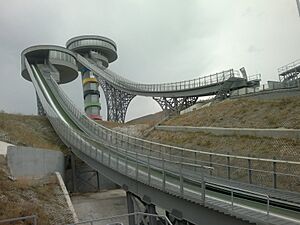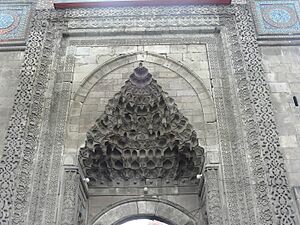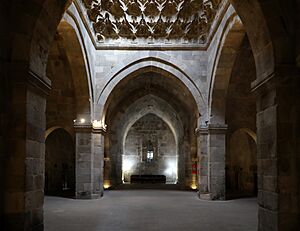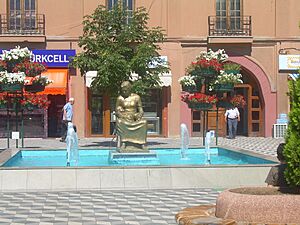Erzurum facts for kids
Quick facts for kids
Erzurum
|
|
|---|---|
|
Metropolitan municipality
|
|
|
Clockwise from top: Erzurum Citadel, Çifte Minareli Medrese, Yakutiye Medresesi, Erzurum Congress Museum, The Three Kümbets (Üç Kümbetler), K-95 and K-125 ski jumping towers at the Mt. Palandöken ski resort, Atatürk Monument
|
|
| Country | Turkey |
| Province | Erzurum Province |
| Elevation | 1,890 m (6,200 ft) |
| Population
(2021)
|
|
| • Urban | 767,848 |
| Time zone | UTC+3 (TRT) |
| Climate | Dfb |
Erzurum is a city in eastern Anatolia, Turkey. It is the largest city and capital of Erzurum Province. The city is located high up, about 1,900 meters (6,233 feet) above sea level. In 2010, Erzurum had a population of 367,250 people. It is also known as the ancient city of Theodosiopolis.
The city uses a double-headed eagle as its symbol. This symbol has been common in Anatolia for a very long time, even since the Bronze Age.
Erzurum is famous for its winter sports facilities. It hosted the 2011 Winter Universiade, which is like the Olympics for university athletes. It also hosted the 2023 Winter Deaflympics in March 2024.
Contents
- What's in a Name? The History of Erzurum's Names
- A Journey Through Time: Erzurum's History
- Erzurum's Economy
- Fun Things to See: Tourism in Erzurum
- Culture and Food
- Learning in Erzurum: Education
- Sports in Erzurum
- Erzurum's Weather
- Famous People from Erzurum
- Erzurum's Sister Cities
- Images for kids
- See also
What's in a Name? The History of Erzurum's Names
The city was first known as Karno K'aghak' in Armenian. This means "city of Karin". It was named after a local tribe called the Karenitis. Another idea is that it was named after a princely family called the Kamsarakans.
During Roman times, Erzurum was called Theodosiopolis. This name came from Emperor Theodosius I. On old maps, it was also called Autisparate. After the Arabs took over in the 600s, they called it Kālīkalā. This name also came from the original Armenian name, Karno K'aghak'.
The city got its current name after the Seljuk Turks conquered it in 1071. Before that, in 1048, a nearby city called Artze was attacked by the Seljuks. Many people from Artze, including Armenians and Assyrians, moved to Theodosiopolis. They started calling their new home Artsn Rum. This meant 'Artze of the Rûm', referring to the Romans.
Some older stories say the name Erzurum comes from the Arabic words Arḍu ar-Rūm. This means 'land of the Rûm'. For a short time, when the Georgians ruled, the city was known as Karnu-kalaki. Other ways to spell the name include Erzerum and Arzrum.
A Journey Through Time: Erzurum's History
Early Days
The area around Erzurum was once part of the Urartian kingdom. Later, it was known as Karin by the Armenians. It was an important city in the Armenian kingdom. In 387 AD, Armenia was divided. The city then became part of the Eastern Roman Empire. The Romans made it a strong fortress and renamed it Theodosiopolis.
This city was very important for defense along the empire's eastern border. It was often fought over by the Byzantines and Persians. Emperors Anastasius I and Justinian I both made the city's defenses stronger.
The Middle Ages

In 700 AD, the city was taken by the Umayyad general Abdallah ibn Abd al-Malik. It became the capital of an Arab region called Ḳālīḳalā. It was used as a base for attacks into Byzantine lands. Even though it was an Arab area in Christian Armenian lands, the local people often supported the Arab governors.
Byzantine forces captured Theodosiopolis twice, in 931 and 949. Its Arab people were sent away, and Greeks and Armenians settled there. Emperor Basil II rebuilt the city and its defenses in 1018. In 1071, after the Battle of Manzikert, the Seljuk Turks took control. The Saltukids then ruled Erzurum from 1071 to 1202.
Theodosiopolis fought off many attacks from the Seljuks and Georgians. But in 1201, the Seljuk sultan Süleymanshah II conquered the city. In 1242, Erzurum was attacked by the Mongols. The city was damaged and looted. After the Sultanate of Rum fell, Erzurum was ruled by different groups. These included the Ilkhanate, the Empire of Trebizond, the Çoban beylik, Black Sheep Turkmen, Timur Lenk's empire, and White Sheep Turkmen.
Finally, the city came under Safavid Persia rule. But in 1514, the Ottomans led by Selim I conquered it after the Battle of Chaldiran. During Ottoman rule, Erzurum was a key military base in the area. It was the capital of the eyalet of Erzurum. In the 1600s, the province faced threats from Safavid Persia and local rebellions. In 1733, the Iranian ruler Nader Shah took Erzurum. But after he died in 1747, the city returned to Ottoman control.
Modern Times
In 1821, the Ottomans were defeated at Erzurum by the Iranian Qajars. In 1829, the city was captured by the Russian Empire. But it was given back to the Ottoman Empire later that year. During the Crimean war, Russian forces came close to Erzurum but did not attack. The city was attacked by a Russian army in the Russo-Ottoman War of 1877–78, but they did not succeed. However, in February 1878, the Russians took Erzurum without a fight. It was again returned to the Ottoman Empire.
World War I and Turkish War of Independence
During World War I, Erzurum was a key battleground in the Caucasus Campaign. Russian forces, led by Grand Duke Nicholas and Nikolai Nikolaevich Yudenich, captured Erzurum on February 16, 1916. The city returned to Ottoman control in March 1918.
In 1919, Mustafa Kemal Atatürk, who later founded the modern Turkish Republic, resigned from the Ottoman army in Erzurum. He was made an "Honorary Native" of the city. The Erzurum Congress of 1919 was an important meeting that helped start the Turkish War of Independence.
Erzurum's Economy
One of the biggest sources of income for Erzurum is Atatürk University. It was started in 1950 and is one of Turkey's largest universities. It has over forty thousand students. Tourism also brings money to the province. The city is a popular place for winter sports at the nearby Palandöken Mountain.
Erzurum is known for making small items from Oltu stone. These are often sold as souvenirs. They include prayer beads, bracelets, necklaces, and other jewelry.
Erzurum is also important for energy. It is the end point of the South Caucasus Pipeline, which brings natural gas from Baku and Tbilisi. Erzurum will also be the starting point for the planned Nabucco pipeline. This pipeline will carry natural gas from the Caspian Sea to countries in the European Union.
Fun Things to See: Tourism in Erzurum
Not many old buildings from medieval Erzurum are left. But you can still see the old citadel fortress. The 13th-century Çifte Minareli Medrese (the "Twin Minaret" madrasa) is also a must-see. Visitors might also want to see the Çobandede Bridge, which is from the late 1200s. The Lala Mustafa Pasha Mosque and the Grand Mosque are also popular.
Culture and Food
Delicious Erzurum Cuisine
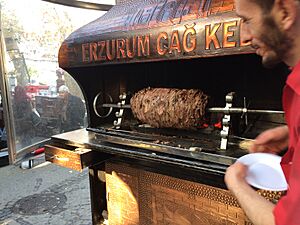
One special dish from Erzurum is Cağ Kebab. This type of kebab is becoming very popular across Turkey.
Kadayıf Dolması is a wonderful dessert made with walnuts.
Other local foods include Su böreği (a wet pastry) and ekşili dolma (sour stuffed vegetables). You can also try kesme çorbası (a soup) and ayran aşı yayla çorbası (nomads soup). Don't forget şalgam dolması (stuffed turnip) and yumurta pilavı (egg pilaf).
Learning in Erzurum: Education
Erzurum is home to two universities: the Erzurum Technical University and the Atatürk University.
Sports in Erzurum
Sports Venues
Erzurum has several great sports venues:
- Kazım Karabekir Stadium
- Erzurum Ice Hockey Arena
- GSIM Yenişehir Ice Hockey Hall
- Milli Piyango Curling Arena
- Kiremitliktepe Ski Jump
Big Sports Events Hosted
Erzurum has hosted many international winter sports events:
- The 11th World Ice Hockey U18 Championships – Division III – Group B Tournament in 2009.
- The 12th World Ice Hockey U18 Championships – Division III – Group A Tournament in 2010.
- The 25th 2011 Winter Universiade in 2011.
- The 2012 World Mixed Doubles Curling Championship in 2012.
- The 2012 European Curling Championships – Group C Tournament in 2012.
- The 11th 2012 IIHF World Championship Division III in 2012.
- The 2017 European Youth Olympic Winter Festival in 2017.
Erzurum's football team, BB Erzurumspor, plays in Turkish football leagues. Their stadium, the Erzurum Cemal Gürsel Stadium, can hold 21,900 people. New facilities like a ski jumping ramp, an ice hockey arena, and a curling hall were built for the Winter Universiade.
Erzurum's Weather
Erzurum has a humid continental climate. This means it has very cold, snowy winters and warm, dry summers. In August, the average high temperature is around 28°C (82°F). The hottest temperature ever recorded was 36.5°C (97.7°F) on July 31, 2000. January is the coldest month, with average low temperatures around -16°C (3°F). The coldest temperature ever recorded was -37.2°C (-35°F) on December 28, 2002. Snow often covers the ground in winter, but the dry climate usually prevents huge amounts of snow from piling up.
| Climate data for Erzurum (1991–2020 normals, extremes 1929–2023) | |||||||||||||
|---|---|---|---|---|---|---|---|---|---|---|---|---|---|
| Month | Jan | Feb | Mar | Apr | May | Jun | Jul | Aug | Sep | Oct | Nov | Dec | Year |
| Record high °C (°F) | 10.4 (50.7) |
10.6 (51.1) |
21.4 (70.5) |
26.5 (79.7) |
29.6 (85.3) |
32.3 (90.1) |
35.6 (96.1) |
36.5 (97.7) |
33.3 (91.9) |
27.0 (80.6) |
20.7 (69.3) |
14.0 (57.2) |
36.5 (97.7) |
| Mean daily maximum °C (°F) | −4.0 (24.8) |
−2.4 (27.7) |
3.9 (39.0) |
12.1 (53.8) |
17.6 (63.7) |
22.9 (73.2) |
27.7 (81.9) |
28.5 (83.3) |
23.7 (74.7) |
16.4 (61.5) |
7.3 (45.1) |
−1.2 (29.8) |
12.7 (54.9) |
| Daily mean °C (°F) | −10.2 (13.6) |
−8.8 (16.2) |
−1.9 (28.6) |
5.5 (41.9) |
10.5 (50.9) |
14.8 (58.6) |
19.1 (66.4) |
19.5 (67.1) |
14.3 (57.7) |
8.1 (46.6) |
0.2 (32.4) |
−7.1 (19.2) |
5.3 (41.5) |
| Mean daily minimum °C (°F) | −15.9 (3.4) |
−14.7 (5.5) |
−7.5 (18.5) |
−0.7 (30.7) |
3.4 (38.1) |
6.1 (43.0) |
9.9 (49.8) |
10.0 (50.0) |
4.4 (39.9) |
0.3 (32.5) |
−6.0 (21.2) |
−12.4 (9.7) |
−1.9 (28.6) |
| Record low °C (°F) | −36.0 (−32.8) |
−37.0 (−34.6) |
−33.2 (−27.8) |
−22.4 (−8.3) |
−7.1 (19.2) |
−5.6 (21.9) |
−1.8 (28.8) |
−1.1 (30.0) |
−6.8 (19.8) |
−14.1 (6.6) |
−34.3 (−29.7) |
−37.2 (−35.0) |
−37.2 (−35.0) |
| Average precipitation mm (inches) | 16.2 (0.64) |
19.4 (0.76) |
34.9 (1.37) |
55.9 (2.20) |
72.4 (2.85) |
42.1 (1.66) |
21.9 (0.86) |
16.5 (0.65) |
22.7 (0.89) |
46.8 (1.84) |
25.6 (1.01) |
21.3 (0.84) |
395.7 (15.58) |
| Average precipitation days | 10.63 | 11.07 | 12.8 | 14.93 | 16.8 | 10.73 | 6.93 | 6.17 | 5.3 | 10.3 | 8.77 | 11.23 | 125.7 |
| Average relative humidity (%) | 79.9 | 79.6 | 75.5 | 68.0 | 65.7 | 60.8 | 53.6 | 49.7 | 52.8 | 65.8 | 74.3 | 81.4 | 67.2 |
| Mean monthly sunshine hours | 108.5 | 121.5 | 155.0 | 183.0 | 235.6 | 300.0 | 331.7 | 316.2 | 252.0 | 201.5 | 144.0 | 89.9 | 2,438.9 |
| Mean daily sunshine hours | 3.5 | 4.3 | 5.0 | 6.1 | 7.6 | 10.0 | 10.7 | 10.2 | 8.4 | 6.5 | 4.8 | 2.9 | 6.7 |
| Source 1: Turkish State Meteorological Service | |||||||||||||
| Source 2: NOAA (humidity, 1991–2020) | |||||||||||||
Famous People from Erzurum
Many notable people have come from Erzurum:
Armenians
- Hakop Karnetsi (1618–1673), an Armenian historian and geographer.
- Ghoukas Karnetsi (1722–1799), a religious leader for Armenians.
- Hovhannes Karnetsi (1750–1820), an Armenian poet and teacher.
- Armenak Arzrouni (1901–1963), an Armenian photographer.
- Nikita Balieff, an Armenian stage performer.
- Arshak Gafavian, an Armenian military commander.
- Johannes Avetaranian (also known as Mehmet Sükrü), a Christian missionary.
- Karekin Pastermadjian, a leader of the Armenian Revolutionary Federation.
- Vartkes Serengülian, an Armenian deputy in the Ottoman parliament.
Turks
- Acun Ilıcalı, a famous television programmer.
- Adnan Polat, former President of Galatasaray football club.
- Arif Sağ, a Turkish singer and musician.
- Bülent Güven, a political scientist and politician.
- Cemal Gürsel, the fourth president of Turkey.
- Fethullah Gülen, an Islamic writer and preacher.
- Hasan Çelebi, a world-famous Islamic calligrapher.
- Huseyin Avni Ulas, an influential politician in early Turkey.
- İbrahim Hakkı Erzurumi, a Turkish philosopher.
- Nene Hatun, a brave woman who defended Erzurum during the Russo-Turkish War of 1877–78.
- Orhun Ene, a Turkish basketball player.
- Ömer Nasuhi Bilmen, an Islamic scholar.
- Recep Akdağ, a former minister of health of Turkey.
- Şair Nef'i, a 17th-century Turkish poet.
- Şakir Yavuz, a Turkish-German business executive.
Others
- Markos Vafiadis, a leader of the Communist Party of Greece.
Erzurum's Sister Cities
Erzurum has friendly ties with these cities:
 Shusha, Azerbaijan
Shusha, Azerbaijan Urmia, Iran (since 2015)
Urmia, Iran (since 2015)
Images for kids
See also
 In Spanish: Erzurum para niños
In Spanish: Erzurum para niños









